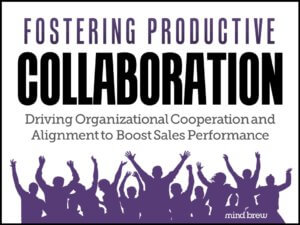It’s been said that, “Money is not the only answer, but it makes a difference.” That’s especially true when it comes to changing the behavior of your sales team. Money isn’t the only way to get salespeople to do things differently, but it sure does help.
People who pursue careers with commission-based pay tend to be people who are motivated by financial gain. And that means that your compensation program is one of the best levers you have for moving your sales force in one direction or another.
Unfortunately, the people who design sales compensation programs often don’t think like salespeople. Managers often focus on what is good for the company, not what is good for them individually. And sometimes they put a plan into place without thinking it through from the sales representatives’ perspectives. Unfortunately, the results are often disastrous.
Here are four of the most common mistake we see B2B firms make when setting up their sales comp plans:
1. Tactical Thinking. While strategy aims at long-term results, tactics are all about what’s happening right here and now. When you design your sales comp plan, you definitely want to concentrate more on the former than the latter.
Here’s an example of how tactical thinking can go catastrophically wrong.
Imagine that your CEO has decided that for the next quarter, your firm is going to concentrate on winning market share from your biggest competitor. If that quarter also happens to be the time when you are revamping your sales comp plan, it might seem like a good idea to incentivize your sales force to target those customers. So you announce that sales reps will get double commissions on any new accounts that are former XYZ Company customers.
The new plan would probably have the desired short-term effect of increasing your market share relative to this competitor, but the long-term effects could be an unmitigated disaster. The sales team would probably focus primarily on those new customers, neglecting long-standing relationships. And they might offer deep discounts to win that new business. After all, they could offer up to half off and still take home the same commission check. But that approach torpedoes the company’s margins. Even worse, it conditions the customers to purchase based on price, and it embroils your company in a price war with a competitor who is now really ticked off.
2. Unchecked Optimism. When designing your sales comp plan, it’s tempting to assume that your sales team has the company’s best interest at heart. However, you can’t discount the very human tendency to “game the system.”
Imagine that you want to drive a lot of sales before the close of your fiscal year, so you announce that you’ll give a free trip to Hawaii to the sales rep who brings in the most revenue for the month of December. Your sales reps each average about $50,000 in revenue per month, so to make sure that everyone works extra hard, you also announce that the winner must have at least $65,000 in sales.
It seems like a foolproof plan. But in your optimism, you have failed to account for Jerry, the sales rep who doesn’t like to work hard but is awfully clever.
Jerry would really, really like to go to Hawaii, and he sees an opportunity to get their for a fraction of the usual price. Jerry approaches his fellow sales reps Brenda and Ray, who aren’t very interested in going to Hawaii but would like some extra cash to buy presents. Together, the three of them decide that after Brenda and Ray have met their monthly quotas, they will enter all the rest of their sales for the month under Jerry’s name. Jerry will kick back Brenda and Ray’s usual commissions, plus a little extra. The net result is that Jerry easily wins the trip competition, while Brenda and Ray each take home a little extra money, and none of them did any extra work. The three of them each get exactly what they wanted — but the company and the rest of the hard-working sales team are left in the lurch.
3. All Carrots, No Sticks. If you’ve spent any time at all watching the plethora of “animal whisperer” shows on television, you’ve seen the power of positive reinforcement to change the behavior of dogs, cats, horses and other four-legged beasts. Since the same principles generally apply to people as well, you probably made sure to include lots of incentives for good behavior in your sales compensation plan.
Just don’t forget that even the best trainers sometimes have to correct animals after bad behavior (albeit in a calm and gentle manner).
In B2B firms, this mistake usually takes the form of paying commissions based on revenues only. This is a very powerful sales motivator, but it doesn’t do much to correct the common bad salesperson behavior of pricing too low. If your plan doesn’t also include some disincentives for discounting or failing to meet price targets, your plan may increase sales while ultimately driving the company out of business.
4. Not Rocking the Boat. And the most common mistake of all is just to do nothing. Even in the face of obvious evidence that the current sales comp plan is failing to increase sales and is possibly even harming margins, managers will cling to the existing plan. After all, no one wants to upset the sales team.
But the truth is, sometimes it is best for the company to change its comp plan, even if it irritates some team members or causes them to move on to another job. After all, the goal of your sales comp plan should be long-term financial success for the organization, not short-time avoidance of conflict.
For tips on how to avoid these common pitfalls and suggestions for creating a successful compensation system, check out the express guide Designing Sales Comp Plans that Actually Work. It includes 10 tried and true strategies for setting up salaries and commissions the right way. And that can make a big difference.











